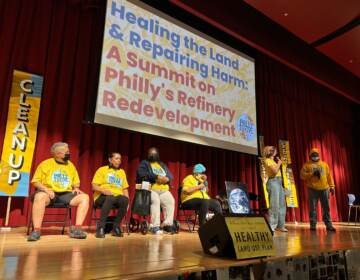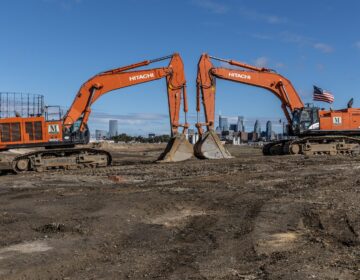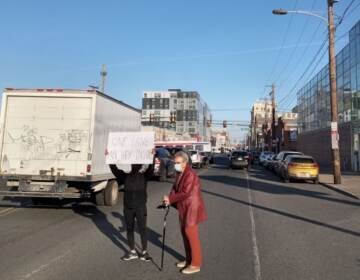Warehouse construction begins at former South Philly refinery site
The 300,000-square-foot building is the first of dozens planned for the demolished site of the largest refinery on the East Coast.
Listen :54
The former site of the PES Refinery in South Philadelphia is in the construction phase of becoming the Bellwether District in October of 2023. (Kimberly Paynter/WHYY)
Have a question about Philly’s neighborhoods or the systems that shape them? PlanPhilly reporters want to hear from you! Ask us a question or send us a story idea you think we should cover.
The site of what was once the largest oil refinery on the East Coast has officially entered a new stage of its evolution.
Construction of the first warehouse on the site has started, with concrete panels already erected and structural steel construction scheduled to start later this month. Developers estimate the more than 300,000-square-foot building will be finished by the end of 2024.
“The entire HRP team is excited to see the vision of The Bellwether District transforming into reality,” Roberto Perez, CEO of Hilco Redevelopment Partners, the company developing the site, said in a statement. “This is a generational opportunity for the city that started it all, and we are proud to contribute to Philadelphia’s ongoing development.”
The PES refinery permanently shut down after a fire and series of explosions in 2019, which sent a piece of a vessel the size of a bus hurtling across the river and released over 5,000 pounds of dangerous hydrofluoric acid into the air.
Parts of the 1,300-acre site along the Schuylkill River in South and Southwest Philadelphia had been used for petroleum-related industry since the Civil War era. The soil and groundwater beneath the site are contaminated. Both Hilco Redevelopment Partners and Evergreen — an affiliate of former owner Sunoco — are responsible for remediating the site.
The refinery operator declared bankruptcy after the fire and laid off over 1,000 employees. Hilco bought the site in 2020 for $225 million, and since then has largely demolished its jungle of tanks, pipes and buildings and begun preparing the site for construction.
HRP plans to build a logistics campus as well as a manufacturing and research and development hub called The Bellwether District at the South Philly portion of the site, with a combined roughly 14 million square feet of building space.
The second, more than 700,000-square-foot building in the logistics portion of the site is also expected to start vertical construction this year.
Much of the South Philly site is in the 100-year and 500-year floodplains, so HRP is using soil from higher elevation areas of the site to raise the low-lying areas.
When operating, PES was the single largest source of unhealthy particulate pollution and planet-warming carbon emissions in the city. It was also at times the largest emitter of cancer-causing benzene among refineries nationwide. During the decommissioning and demolition period, monitors at the site’s perimeter continued to detect benzene — which is found in crude oil and gasoline.
HRP stopped monitoring for benzene specifically in 2023 after the site was reclassified and no longer subject to the EPA’s benzene monitoring requirements for active refineries. HRP now monitors for dust and overall levels of a category of air pollutants known as volatile organic compounds, which include benzene, at several points along the fence line — and posts these results online.
The warehouse buildings HRP is constructing will be heated with gas but are built to support rooftop solar.
HRP notes the closure of the refinery significantly reduced Philly’s carbon emissions. But the warehouses, if served by diesel-powered trucks, could bring tailpipe emissions that contribute to climate change and local health impacts, such as asthma.
Community benefit agreement talks between HRP and more than two dozen local Registered Community Organizations and other stakeholders started last spring. The company said it hopes to sign a completed CBA this year.
Some nearby residents and activists have called for fossil fuel-free development on the site, as well as guarantees around employment, anti-displacement and environmental health.
The manufacturing and R&D portion of the development could start vertical construction in early 2025. Remediation is expected to continue through at least 2025.

Subscribe to PlanPhilly
WHYY is your source for fact-based, in-depth journalism and information. As a nonprofit organization, we rely on financial support from readers like you. Please give today.









